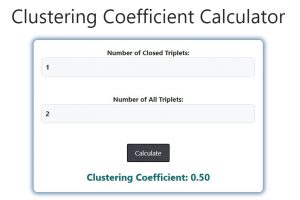About Clustering Coefficient Calculator (Formula)
The Clustering Coefficient Calculator is an essential tool for researchers and data analysts working in fields like network analysis, sociology, and graph theory. It measures the degree to which nodes in a graph tend to cluster together. This metric provides insights into the connectivity and structure of networks, making it useful for studying social networks, biological networks, and more. By understanding the clustering coefficient, you can gain valuable insights into the behavior and characteristics of complex systems.
Formula
The formula for calculating the clustering coefficient is:
Clustering Coefficient (C) = Number of Closed Triplets / Number of All Triplets
Where:
- Closed Triplets refer to sets of three nodes that are all interconnected.
- All Triplets include any arrangement of three nodes, whether they are connected or not.
How to Use
Using the Clustering Coefficient Calculator involves a few simple steps:
- Gather Data: Collect data on the nodes and their connections in your network.
- Count Triplets: Identify all triplets within the network. This includes both closed and open triplets.
- Count Closed Triplets: Specifically count the number of triplets where all three nodes are interconnected.
- Input Values: Enter the number of closed triplets and the total number of triplets into the calculator.
- Calculate: Click the calculate button to determine the clustering coefficient, which will give you insight into the clustering tendency of your network.
Example
Consider a social network with the following connections:
- Nodes A, B, and C are interconnected (forming a closed triplet).
- Nodes D, E, and F are connected in a way that forms a chain (forming an open triplet).
In this example:
- Closed Triplets: 1 (A, B, C)
- Open Triplets: 1 (D, E, F)
Total Triplets = 2 (1 closed + 1 open)
Using the formula:
Clustering Coefficient (C) = Number of Closed Triplets / Number of All Triplets
C = 1 / 2
C = 0.5
This indicates that the clustering tendency of this social network is moderate.

FAQs
- What is a clustering coefficient?
The clustering coefficient measures the degree to which nodes in a graph tend to cluster together. - Why is the clustering coefficient important?
It provides insights into the structure and connectivity of networks, helping to identify tightly-knit groups. - What is the difference between closed and open triplets?
Closed triplets have all three nodes interconnected, while open triplets do not have all nodes connected. - Can the clustering coefficient be greater than 1?
No, the clustering coefficient is always between 0 and 1. - What does a clustering coefficient of 0 indicate?
A coefficient of 0 means there are no closed triplets in the network; nodes do not cluster together. - What does a clustering coefficient of 1 indicate?
A coefficient of 1 means every possible triplet in the network is closed, indicating maximum clustering. - How can I visualize clustering in a network?
Graphical representations such as network diagrams can help visualize how nodes connect and cluster. - Is the clustering coefficient used in social network analysis?
Yes, it is commonly used to study social relationships and group dynamics. - Can the clustering coefficient help in detecting communities within a network?
Yes, higher clustering coefficients often indicate the presence of communities or tightly-knit groups within networks. - What types of networks can the clustering coefficient be applied to?
It can be applied to various networks, including social networks, biological networks, and technological networks. - How do you calculate triplets in a large network?
For large networks, algorithms can be used to efficiently identify and count triplets. - Can clustering coefficients differ between directed and undirected graphs?
Yes, the calculation may differ based on the nature of the graph (directed or undirected). - What tools can I use to calculate clustering coefficients?
Various software tools and programming libraries, such as NetworkX in Python, can help calculate clustering coefficients. - How does the clustering coefficient relate to network robustness?
Higher clustering can enhance network robustness by providing alternative pathways for information flow. - What is the significance of low clustering coefficients in biological networks?
Low clustering may indicate more random or sparse connections, which can affect the function and stability of biological systems. - How often should the clustering coefficient be calculated?
It can be beneficial to calculate it periodically, especially in dynamic networks where connections may change over time. - Can clustering coefficients be compared across different networks?
Yes, they can be compared to understand relative clustering tendencies, but consider the context of each network. - What other metrics are used alongside the clustering coefficient?
Metrics like average path length and degree distribution are often used together for comprehensive network analysis. - How does clustering coefficient impact information spread in networks?
Higher clustering can facilitate faster information spread within tightly-knit groups. - Are there any limitations to using the clustering coefficient?
Yes, it may not capture all aspects of network structure, and context-specific analysis is often required.
Conclusion
The Clustering Coefficient Calculator is a powerful tool for understanding the clustering tendencies in various networks. By measuring how nodes group together, researchers can gain valuable insights into the underlying structure and dynamics of complex systems. Whether in social networks, biological systems, or technological networks, the clustering coefficient provides essential information for effective analysis and decision-making.